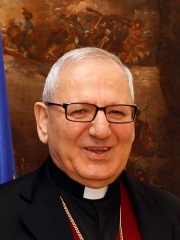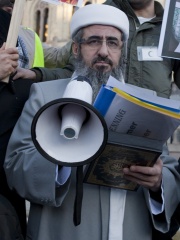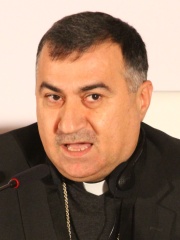
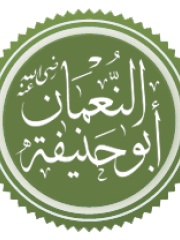
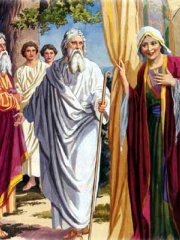
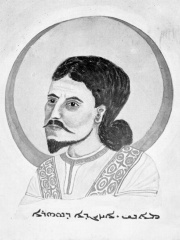
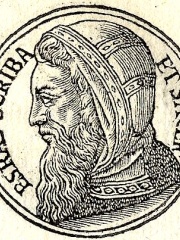
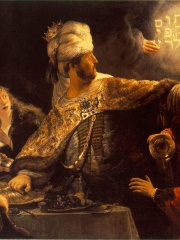

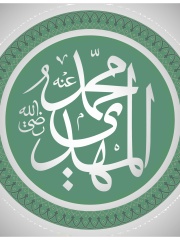
The Most Famous
RELIGIOUS FIGURES from Iraq
This page contains a list of the greatest Iraqi Religious Figures. The pantheon dataset contains 2,238 Religious Figures, 35 of which were born in Iraq. This makes Iraq the birth place of the 15th most number of Religious Figures behind Greece and Russia.
Top 10
The following people are considered by Pantheon to be the top 10 most legendary Iraqi Religious Figures of all time. This list of famous Iraqi Religious Figures is sorted by HPI (Historical Popularity Index), a metric that aggregates information on a biography’s online popularity. Visit the rankings page to view the entire list of Iraqi Religious Figures.

1. Abraham (-1813 - -1638)
With an HPI of 91.87, Abraham is the most famous Iraqi Religious Figure. His biography has been translated into 152 different languages on wikipedia.
Abraham (originally Abram) is the common Hebrew patriarch of the Abrahamic religions, including Judaism, Christianity, and Islam. In Judaism, he is the founding father of the special relationship between the Jews and God; in Christianity, he is the spiritual progenitor of all believers, whether Jewish or non-Jewish; and in Islam, he is a link in the chain of Islamic prophets that begins with Adam and culminates in Muhammad. The story of the life of Abraham as told in the narrative of the Book of Genesis in the Hebrew Bible revolves around the themes of posterity and land. He is said to have been called by God to leave the house of his father Terah and settle in the land of Canaan, which God now promises to Abraham and his progeny. This promise is subsequently inherited by Isaac, Abraham's son, by his wife Sarah, while Isaac's half-brother Ishmael is also promised that he will be the founder of a great nation. Abraham purchases a tomb (the Cave of the Patriarchs) at Hebron to be Sarah's grave, thus establishing his right to the land; and, in the second generation, his heir Isaac is married to a woman from his own kin to earn his parents' approval. Abraham later marries Keturah and has six more sons; but, on his death, when he is buried beside Sarah, it is Isaac who receives "all Abraham's goods" while the other sons receive only "gifts". Most scholars view the patriarchal age, along with the Exodus and the period of the biblical judges, as a late literary construct that does not relate to any particular historical era, and after a century of exhaustive archaeological investigation, no evidence has been found for a historical Abraham. It is largely concluded that the Torah, the series of books that includes Genesis, was composed during the early Persian period, c. 500 BC, as a result of tensions between Jewish landowners who had stayed in Judah during the Babylonian captivity and traced their right to the land through their "father Abraham", and the returning exiles who based their counterclaim on Moses and the Exodus tradition of the Israelites.

2. Abu Hanifa (698 - 767)
With an HPI of 78.82, Abu Hanifa is the 2nd most famous Iraqi Religious Figure. His biography has been translated into 64 different languages.
Abu Hanifa (Arabic: أَبُو حَنِيفَة, romanized: Abū Ḥanīfa; September 699–767) was a Sunni Muslim scholar, jurist, theologian, ascetic, and eponym of the Hanafi school of Islamic jurisprudence, which remains the most widely practiced to this day. His school predominates in Central Asia, Afghanistan, Iran (until the sixteenth century), Turkey, the Balkans, Russia, Circassia, Pakistan, Bangladesh, India, and some parts of the Arab world. Born to a Muslim family in Kufa, Abu Hanifa traveled to the Hejaz region of Arabia in his youth, where he studied in the Islamic holy cities of Mecca and Medina. He was named by al-Dhahabi as "one of the geniuses of the sons of Adam" who "combined jurisprudence, worship, scrupulousness, and generosity". As his career as a jurist and theologian progressed, he became known for favoring the use of reason in his jurisprudential rulings, and even in his theology. His school grew after his death, and the majority of its followers would also come to follow the Maturidi school of theology. He left behind two major students, Abu Yusuf and Muhammad al-Shaybani, who would later become celebrated jurists in their own right.

3. Sarah (-1803 - -1676)
With an HPI of 75.83, Sarah is the 3rd most famous Iraqi Religious Figure. Her biography has been translated into 61 different languages.
Sarah (born Sarai) is a biblical matriarch, prophet, and major figure in Abrahamic religions. While different Abrahamic faiths portray her differently, Judaism, Christianity, and Islam all depict her character similarly, as that of a pious woman, renowned for her hospitality and beauty, the wife and half-sister of Abraham, and the mother of Isaac. Sarah has her feast day on 1 September in the Catholic Church, 19 August in the Coptic Orthodox Church, 20 January in the LCMS, and 12 and 20 December in the Eastern Orthodox Church.

4. Mani (216 - 274)
With an HPI of 73.85, Mani is the 4th most famous Iraqi Religious Figure. His biography has been translated into 61 different languages.
Mani (Persian: مانی, c. April AD 216–2 March AD 274 or 26 February AD 277) was an Iranian prophet and the founder of Manichaeism, a religion most prevalent in late antiquity. Mani was born in or near Seleucia-Ctesiphon (south of modern Baghdad) in Mesopotamia, at the time part of the Parthian Empire. Seven of his major works were written in Syriac, and the eighth, dedicated to the Sasanian emperor Shapur I, was written in Middle Persian. He died in Gundeshapur.
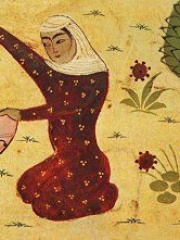
5. Rabia of Basra (710 - 801)
With an HPI of 72.88, Rabia of Basra is the 5th most famous Iraqi Religious Figure. Her biography has been translated into 46 different languages.
Rābiʼa al-ʼAdawiyya al-Qaysiyya (Arabic: رابعة العدوية القيسية; c. 716 – 801 CE) was an Arab Muslim saint, one of the earliest Sufi mystics and an influential religious figure. She is known in some parts of the world as Hazrat Rabia Basri, Rabia Al Basri or simply Rabia Basri. She is considered by many Muslims to be an example of piety and is a part of the complicated early history of Islam.

6. Ezra (-500 - -401)
With an HPI of 71.92, Ezra is the 6th most famous Iraqi Religious Figure. His biography has been translated into 48 different languages.
Ezra or Esdras (; Hebrew: עֶזְרָא, ʿEzrāʾ; fl. 480–440 BCE), also called Ezra the Scribe (עֶזְרָא הַסּוֹפֵר ʿEzrāʾ hasSōfēr) in Chazalic literature and Ezra the Priest, was an important Jewish scribe (sofer) and priest (kohen) in the early Second Temple period. In Greco-Latin Ezra is called Esdras (Greek: Ἔσδρας). His name is probably a shortened Aramaic translation of the Hebrew name עזריהו Azaryahu, "Yah helps". In the Greek Septuagint the name is rendered Ésdrās (Ἔσδρας), from which the Latin name Esdras comes. In the Hebrew Bible, or the Christian Old Testament, Ezra is an important figure in the books of Ezra and Nehemiah, which he is said to have written and edited, respectively. According to tradition, Ezra was also the author of the Books of Chronicles and the Book of Malachi. Ezra was instrumental in restoring the Jewish scriptures and religion to the people after the return from the Babylonian Captivity, and is a highly respected figure in Judaism. He is regarded as a saint in the Roman Catholic Church, which sets his feast day as July 13, the same as that of his contemporary, Nehemiah. He is also venerated as a saint in the Eastern Orthodox Church, which sets his feast day as December 11.

7. Belshazzar (-600 - -600)
With an HPI of 71.37, Belshazzar is the 7th most famous Iraqi Religious Figure. His biography has been translated into 39 different languages.
Belshazzar (Babylonian cuneiform: Bēl-šar-uṣur, meaning "Bel, protect the king"; Hebrew: בֵּלְשַׁאצַּר Bēlšaʾṣṣar) was the son and crown prince of Nabonidus (r. 556–539 BC), the last king of the Neo-Babylonian Empire. Through his mother, he might have been a grandson of Nebuchadnezzar II (r. 605–562 BC), though this is not certain and the claims to kinship with Nebuchadnezzar may have originated from royal propaganda. Belshazzar played a pivotal role in the coup d'état that overthrew the king Labashi-Marduk (r. 556 BC) and brought Nabonidus to power in 556 BC. Since Belshazzar was the main beneficiary of the coup, through confiscating and inheriting Labashi-Marduk's estates and wealth, it is likely that he was the chief orchestrator. Through proclaiming his father as the new king, Belshazzar also made himself the first-in-line to the throne. As Nabonidus was relatively old at the time, Belshazzar could expect to become king within a few years. Nabonidus was absent from Babylon from 553 BC to 543 or 542 BC, in self-imposed "exile" at Tayma in Arabia, for unknown reasons. For the duration of the decade-long absence of his father, Belshazzar served as regent in Babylon. Belshazzar was entrusted with many typically royal prerogatives, such as granting privileges, commanding portions of the army, and receiving offerings and oaths, though he continued to be styled as the crown prince (mār šarri, literally meaning "son of the king"), never assuming the title of king (šarru). Belshazzar also lacked many of the prerogatives of kingship, most importantly he was not allowed to preside over and officiate the Babylonian New Year's festival, which was the exclusive right of the king himself. Belshazzar's fate is not known, but is often assumed that he was killed during Cyrus the Great's Persian invasion of Babylonia in 539 BC, presumably at the fall of the capital Babylon on 12 October 539 BC. Belshazzar appears as a central character in the story of Belshazzar's feast in the Biblical Book of Daniel, recognized by scholars as a work of historical fiction. Daniel's Belshazzar is not malevolent (he, for instance, rewards Daniel for his interpretation of "the writing on the wall"), but in later Jewish tradition Belshazzar was presented as a tyrant who oppresses the Jewish people.

8. Idris (-3500 - )
With an HPI of 70.08, Idris is the 8th most famous Iraqi Religious Figure. His biography has been translated into 46 different languages.
Idris (Arabic: إدريس, romanized: ʾIdrīs) is an ancient prophet mentioned in the Quran, who Muslims believe was the third prophet after Seth. He is the second prophet mentioned in the Quran. Islamic tradition has unanimously identified Idris with the biblical Enoch. Many Muslim scholars of the classical and medieval periods held that Idris and Hermes Trismegistus were the same person. He is described in the Quran as "trustworthy" and "patient" and the Quran also says that he was "exalted to a high station". Because of this and other parallels, traditionally Idris has been identified with the biblical Enoch, and Islamic tradition usually places Idris in the early Generations of Adam, and considers him one of the oldest prophets mentioned in the Quran, placing him between Adam and Noah. Idris' unique status inspired many future traditions and stories surrounding him in Islamic folklore. According to hadith, narrated by Malik ibn Anas and found in Sahih Muslim, it is said that on Muhammad's Night Journey, he encountered Idris in the fourth heaven. The traditions that have developed around the figure of Idris have given him the scope of a prophet as well as a philosopher and mystic, and many later Muslim mystics, or Sufis, including Ruzbihan Baqli and Ibn Arabi, also mentioned having encountered Idris in their spiritual visions.

9. Muhammad al-Mahdi (869 - 941)
With an HPI of 69.31, Muhammad al-Mahdi is the 9th most famous Iraqi Religious Figure. His biography has been translated into 36 different languages.
Muhammad ibn Hasan al-Mahdi (Arabic: محمد بن الحسن المهدي, romanized: Muḥammad ibn al-Ḥasan al-Mahdī) is believed by the Twelver Shia to be the last of the Twelve Imams and the eschatological Mahdi, who will emerge in the end of time to establish peace and justice and redeem Islam. Hasan al-Askari, the eleventh Imam, died in 260 AH (873–874 CE), possibly poisoned by the Abbasids. Immediately after his death, his main representative, Uthman ibn Sa'id, claimed that the eleventh Imam had an infant son named Muhammad, who was kept hidden from the public out of fear of Abbasid persecution. Uthman also claimed to represent Muhammad, who had entered a state of occultation. Other local representatives of al-Askari largely supported these assertions, while the Shia community fragmented into several sects over al-Askari's succession. All these sects, however, are said to have disappeared after a few decades except the Twelvers, who accept the son of al-Askari as the twelfth and final Imam in occultation. Uthman was followed by three more agents, collectively known as the Four Deputies, who were regarded by the Twelver community as representatives of Muhammad al-Mahdi. This period, later termed the Minor Occultation, ended after about seventy years with the death of the fourth agent, Abu al-Hasan Ali ibn Muhammad al-Samarri (d. 940–941). He is said to have received the final letter of Muhammad al-Mahdi shortly before his death. The letter predicted the death of Abu al-Hasan in six days and announced the beginning of the complete occultation, later called the Major Occultation, which continues to this day. The letter, ascribed to Muhammad al-Mahdi, added that the complete occultation would continue until God granted him permission to manifest himself again in a time when the earth would be filled with tyranny. The Twelver theory of occultation crystallized in the first half of the fourth century AH (tenth century CE) based on rational and textual arguments. This theory, for instance, sets forth that the life of Muhammad al-Mahdi has been miraculously prolonged, arguing that the earth cannot be void of the Imam as the highest proof of God. In the absence of the Hidden Imam, the leadership vacuum in the Twelver community was gradually filled by faqīh "jurists". It is popularly held that the Hidden Imam occasionally appears to the pious. The accounts of these encounters are numerous and widespread among the Twelvers.
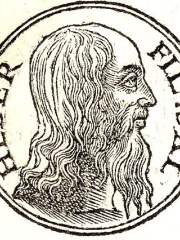
10. Eber (-2038 - -1574)
With an HPI of 68.56, Eber is the 10th most famous Iraqi Religious Figure. His biography has been translated into 38 different languages.
Eber (Hebrew: עֵבֶר, romanized: ʿĒḇer; Biblical Greek: Ἔβερ, romanized: Éber; Arabic: عٰابِر, romanized: ʿĀbir) is an ancestor of the Ishmaelites and the Israelites according to the Generations of Noah in the Book of Genesis (Genesis 10–11) and the Books of Chronicles (1 Chronicles 1).
Pantheon has 35 people classified as religious figures born between 3500 BC and 1970. Of these 35, 3 (8.57%) of them are still alive today. The most famous living religious figures include Louis Raphaël I Sako, Mullah Krekar, and Bashar Warda. The most famous deceased religious figures include Abraham, Abu Hanifa, and Sarah. As of April 2022, 4 new religious figures have been added to Pantheon including Dawud al-Zahiri, Mullah Krekar, and Paulos Faraj Rahho.
Living Religious Figures
Go to all Rankings
Louis Raphaël I Sako
1948 - Present
HPI: 48.52
Mullah Krekar
1956 - Present
HPI: 45.51
Bashar Warda
1969 - Present
HPI: 37.34

Deceased Religious Figures
Go to all Rankings
Abraham
1813 BC - 1638 BC
HPI: 91.87
Abu Hanifa
698 - 767
HPI: 78.82
Sarah
1803 BC - 1676 BC
HPI: 75.83
Mani
216 - 274
HPI: 73.85
Rabia of Basra
710 - 801
HPI: 72.88
Ezra
500 BC - 401 BC
HPI: 71.92
Belshazzar
600 BC - 600 BC
HPI: 71.37
Idris
3500 BC - Present
HPI: 70.08
Muhammad al-Mahdi
869 - 941
HPI: 69.31
Eber
2038 BC - 1574 BC
HPI: 68.56
Ibn Hisham
701 - 833
HPI: 65.77
Junayd of Baghdad
830 - 910
HPI: 65.47

Newly Added Religious Figures (2022)
Go to all Rankings
Dawud al-Zahiri
815 - 883
HPI: 53.66
Mullah Krekar
1956 - Present
HPI: 45.51
Paulos Faraj Rahho
1942 - 2008
HPI: 45.30
Sajida al-Rishawi
1970 - 2015
HPI: 42.21

Which Religious Figures were alive at the same time? This visualization shows the lifespans of the 9 most globally memorable Religious Figures since 1700.

